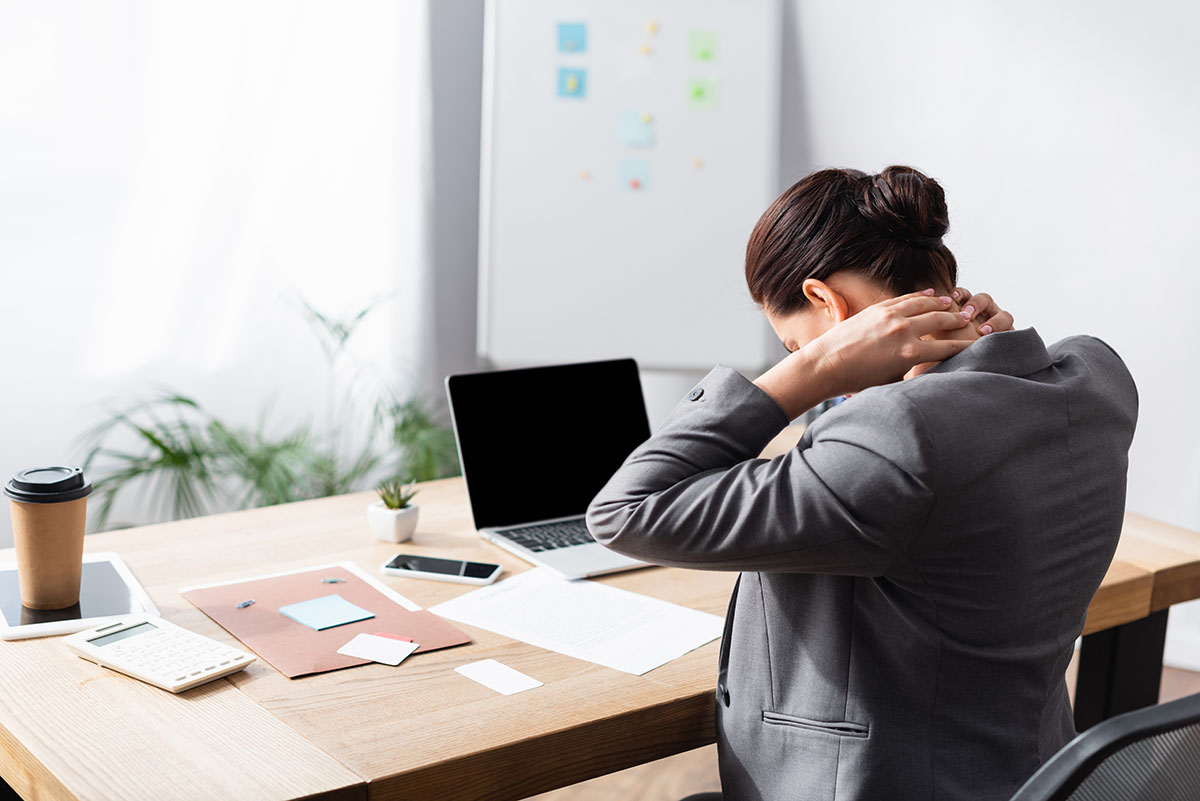Here Are Tips for Avoiding “Tech Neck” …aka, Neck Pain or Headache …
Neck pain is common. Maybe you’ve had the experience where you “slept funny” and woke up with a “crick in your neck,” unable to turn your head due to pain and stiffness. Or perhaps you have been in the car, thinking stressful thoughts, and found your shoulders up by your ears with an ache traveling up your neck.
Maybe this year you’ve spent some time on the phone or watching a screen (just maybe…) until your neck felt stiff and you noticed a headache developing. Some people call this kind of neck pain “tech neck” since they associate the pain and headaches with prolonged use of technology.
In reality, you can get a sensitive or stiff neck from any activity that involves posturing or movement that your body isn’t accustomed to. How do you avoid tech neck and the like? Here are a few tips and things you can do to help:

Posture matters, but movement matters more. Like most joints in the human body, the neck doesn’t like to be held in one position for hours on end. There is no one “best posture” for your neck. Rather, different postures and movements are what our joints crave.
Try to give your neck a break by looking in different directions and taking it through its full range of motion every 1 to 2 hours. These are what people call neck exercises and stretch.
Sometimes it feels good to hold a stretch for 20 to 30 seconds. Try looking down to your chest and holding it there. If you want to, you can add the weight of your hand on your head for extra stretch. Then look up as far as you can. Don’t worry if you get crunchy sounds as you move your neck—this is called “crepitus” and is a normal part of neck movement.
Now try bending your neck to the left and to the right. Try turning it each way also. You can even combine movements, such as looking down and turning your head or looking up and bending to one side.
But posture does matter. If you do have to sit for a while, there are methods you can use to reduce the work of the muscles on the back of your neck. Try to sit up tall, imagining that a string is pulling you upwards from the center of your head. Bring your chin down slightly. (Bonus points if you pull your shoulder blades back a little too!) Putting a small pillow or a rolled-up towel behind your lower back may help, since the posture at the base of your spine affects posture further up, even to your head and neck.
A commonly prescribed neck exercise in physical therapy is “cervical retraction.” Sitting with the tall posture we just discussed, tuck your chin down slightly and push your head straight backward. Hold it there for a second or two before relaxing. (If it feels somewhat awkward, you are probably doing it right.)
This movement is the opposite of the “forward head” posture most of us use when we are reading a book or working on the computer. Retraction strengthens muscles in the front of your neck and provides a balance of motion to the joints of your spine. Remember, “motion is lotion!”
The retraction motion can also help stretch a group of small muscles at the base of your skull/top of your spine called your sub-occipital muscles which have been found to contribute to tension headaches. Many of the muscles on the back of your neck refer pain up into the skull and behind the eyes if the muscles become sensitive and irritated.
Migraine headaches can also have neck pain as a symptom. If your neck pain occurs in episodes and is accompanied by light or sound sensitivity, dizziness, vertigo, nausea, or a desire to go lay down and close your eyes, it may be related to migraine. At WWSPT, we help people with migraines by figuring out triggers and reducing nervous system sensitivity to prevent episodes and decrease symptoms between episodes. The therapy program often includes aerobic exercise, addressing other health habits, and treating neck pain and sensitivity as needed.
Get a good night of sleep. Getting the proper amount of quality sleep affects our perception and experience of pain as well as our mood and many other aspects of life. Unfortunately, neck pain can make it difficult to get comfortable at night. If you sleep primarily on your side, you may like to use a slightly thicker pillow or possibly two pillows to support your neck. If you sleep on your back, you can try putting a rolled-up hand towel at the base of your pillow to provide a little extra support to your neck.
As with any pain, addressing stressors in life and getting consistent aerobic exercise can also be extremely helpful. Aerobic exercise helps with blood flow, tissue healing, decreasing inflammation, and boosting your mood.
A physical therapist is trained to examine your posture, neck mobility, and strength, determine the cause of your neck pain, and develop a treatment program to reduce your pain and prevent a recurrence. Most people benefit from physical therapy treatment that includes a combination of hands-on therapy and exercises.
The physical therapists at WWSPT treat neck pain of all causes, frequently, including not only “tech neck” but neck pain and headaches related to concussion and trauma. If your neck has been bothering you, we’d be happy to help!
Dr. Greg Synnestvedt PT, DPT,
WWS Physical Therapy and Vestibular Rehabilitation
Doylestown, PA. 18901

Leave a Reply